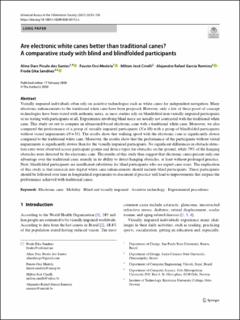| dc.contributor.author | Santos, Aline Darc Piculo | |
| dc.contributor.author | Medola, Fausto Orsi | |
| dc.contributor.author | Cinelli, Milton José | |
| dc.contributor.author | Ramirez, Alejandro Rafael Garcia | |
| dc.contributor.author | Sandnes, Frode Eika | |
| dc.date.accessioned | 2022-07-15T06:45:04Z | |
| dc.date.available | 2022-07-15T06:45:04Z | |
| dc.date.created | 2020-07-16T08:49:51Z | |
| dc.date.issued | 2020 | |
| dc.identifier.citation | Universal Access in the Information Society. 2020, 20, 93-103. | en_US |
| dc.identifier.issn | 1615-5289 | |
| dc.identifier.uri | https://hdl.handle.net/11250/3005644 | |
| dc.description.abstract | Visually impaired individuals often rely on assistive technologies such as white canes for independent navigation. Many electronic enhancements to the traditional white cane have been proposed. However, only a few of these proof-of-concept technologies have been tested with authentic users, as most studies rely on blindfolded non-visually impaired participants or no testing with participants at all. Experiments involving blind users are usually not contrasted with the traditional white cane. This study set out to compare an ultrasound-based electronic cane with a traditional white cane. Moreover, we also compared the performance of a group of visually impaired participants (N = 10) with a group of blindfolded participants without visual impairments (N = 31). The results show that walking speed with the electronic cane is significantly slower compared to the traditional white cane. Moreover, the results show that the performance of the participants without visual impairments is significantly slower than for the visually impaired participants. No significant differences in obstacle detection rates were observed across participant groups and device types for obstacles on the ground, while 79% of the hanging obstacles were detected by the electronic cane. The results of this study thus suggest that electronic canes present only one advantage over the traditional cane, namely in its ability to detect hanging obstacles, at least without prolonged practice. Next, blindfolded participants are insufficient substitutes for blind participants who are expert cane users. The implication of this study is that research into digital white cane enhancements should include blind participants. These participants should be followed over time in longitudinal experiments to document if practice will lead to improvements that surpass the performance achieved with traditional canes. | en_US |
| dc.description.sponsorship | Open Access funding provided by OsloMet - Oslo Metropolitan University. | en_US |
| dc.language.iso | eng | en_US |
| dc.rights | Navngivelse 4.0 Internasjonal | * |
| dc.rights.uri | http://creativecommons.org/licenses/by/4.0/deed.no | * |
| dc.title | Are electronic white canes better than traditional canes? A comparative study with blind and blindfolded participants | en_US |
| dc.type | Peer reviewed | en_US |
| dc.type | Journal article | en_US |
| dc.description.version | publishedVersion | en_US |
| dc.source.pagenumber | 93-103 | en_US |
| dc.source.volume | 20 | en_US |
| dc.source.journal | Universal Access in the Information Society | en_US |
| dc.identifier.doi | 10.1007/s10209-020-00712-z | |
| dc.identifier.cristin | 1819535 | |
| dc.relation.project | Norwegian Centre for International Cooperation in Education: UTF-2016-long-term/10053 | en_US |
| dc.relation.project | CAPES | en_US |
| cristin.ispublished | true | |
| cristin.fulltext | original | |
| cristin.fulltext | postprint | |
| cristin.fulltext | original | |
| cristin.fulltext | postprint | |
| cristin.fulltext | original | |
| cristin.qualitycode | 1 | |

